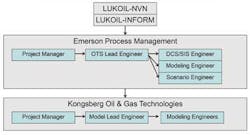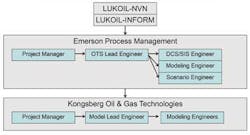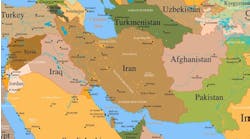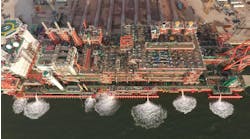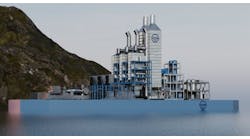View Article as Single page
OTS architecture and functions
Key to achieving that realism is the operator training simulator (OTS), which is designed to replicate exactly the platform's equipment, and was developed with the same Emerson developers who had developed the configuration for the production platform. The idea was to train operators on exactly the same equipment that they would be using in the field, and the OTS uses the same hardware as the platform's DCS and SIS, and runs the same software. It is set up to match the as-installed system, not a "functional equivalent" built from preliminary designs, and uses simulation software that duplicates the configuration exactly as on site: the DCS configuration is an exact copy of the one on the platform, the SIS configuration and emergency shutdown algorithms are exact copies, and the fire and gas alarm configuration is an exact copy. The OTS allows trainees to perform control, start-up, and shutdown procedures for major platform systems, and all scenarios and training courses are customized and configurable.
Hardware for the OTS includes five PC workstations that are connected to the control system emulator that executes the actual control system's DCS/SIS algorithms, using simulated values as the inputs. The PCs can be switched to operate as supervisor workstations, central control room (CCR) operator workstations, or field operator workstations. They connect via a local area network to the instructor workspace, which includes three DeltaV application workstations, a K-Spice model workstation and a DeltaV ProfessionalPlus workstation. Operator screens are exact copies of the operator screens on the platform, and all complexes and systems are available to the central control room operators. Operator screen access level for the technology, power and utility complexes is privilege dependent. Field operator screens emulate the actions of field operator such as opening manual valves and field equipment operation.
The OTS hardware and software are divided into three main parts: control system emulation, a process model and simulator, and facilities for the organization of training, evaluation, and courseware.
Control system model
The control system emulation, as mentioned, is an exact copy of the control system configuration for the platform's DCS, the emergency shutdown system and the fire and gas detection systems. It also provides emulations for local control systems, including compressor startup and anti-surge controls, power generation, and glycol block.
Process model and simulator
The process model, which runs on its own server, calculates process parameters with high accuracy, taking DCS/SIS outputs from the control system emulator as inputs. It has two parts: A high-fidelity technology complex model handles oil and gas production, separation and transport, while a medium-fidelity power and utility complex model handles power generation and distribution, auxiliary systems and life support, where high accuracy is not required.
Technology complex model
The high-fidelity technology complex process model uses K-Spice, from Kongsberg Oil and Gas Technologies. The K-Spice model for the technology complex includes models for 26 production wells plus gas lift, three gas injection wells, and three water injection wells. It also models oil separation, preparation and transport system, the gas compression and injection, fuel gas system, the water treatment system, the TEG (triethylene glycol) system, as well as auxiliaries: chemical injection, flares, drainage, etc. It can be modified and expanded as necessary. Integration with the DCS and SIS system is via a standard OPC server and a custom K-Spice/DeltaV interface. More than 6,000 parameters are interfaced between K-Spice and DeltaV.
Power and utility model
The medium-fidelity power and utility process model uses the SEEDS (Standard Entities for the Engineering of Dynamic Simulators) platform, a medium-fidelity native dynamic simulation that provides a realistic and effective simulation environment within a single integrated database. It includes the models for the power generation system (gas turbine generator and emergency generator); the power distribution system; the diesel fuel and oil system for power objects; the waste heat recovery systems; the life support systems within the production platform; the fire extinguishing systems; and the auxiliary process systems, including water supply, cooling/heating agent, drainage, etc. The SEEDS model also interfaces to the K-Spice model.
